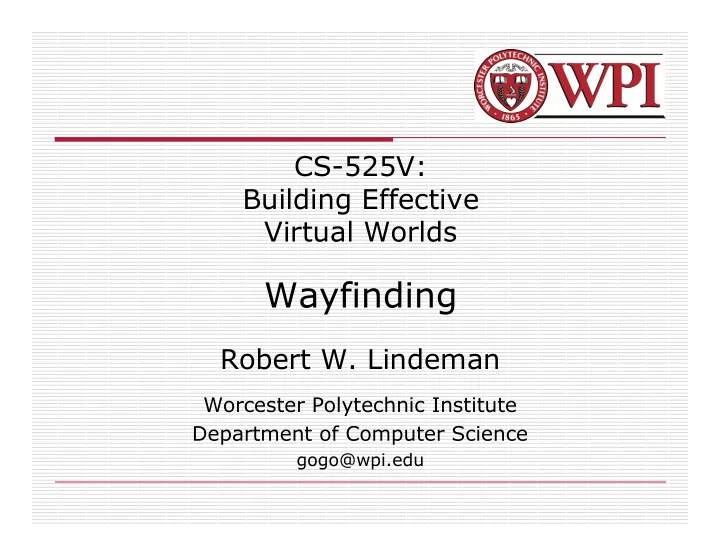

CS-525V: Building Effective Virtual Worlds Wayfinding Robert W. Lindeman Worcester Polytechnic Institute Department of Computer Science gogo@wpi.edu
Plan for Tonight Wayfinding Project Demos R.W. Lindeman - WPI Dept. of Computer Science 2
Navigation Navigation = Travel + Wayfinding Travel is the component of VR that involves moving from one place to another Wayfinding is: Knowing where you are, Knowing where your destination is, and Having some knowledge of how to get there. R.W. Lindeman - WPI Dept. of Computer Science 3
Wayfinding in the Real World How do we do wayfinding in the real world? R.W. Lindeman - WPI Dept. of Computer Science 4
Why Study Wayfinding? Two reasons for wayfinding improvement in VR VR performance enhancement Training transfer We can show that: One set of wayfinding cues works better than another Exposure to wayfinding cues in a VR improve wayfinding in the real world. Spatial Comprehension: The ability to perceive, understand, remember, and recall for future use. R.W. Lindeman - WPI Dept. of Computer Science 5
Spatial Knowledge Acquisition Direct environmental exposure Indirect tools, like maps These can be used outside or inside of the environment Direct cues (urban situations) Landmarks Routes (or paths) between landmarks Nodes are junctions in routes Districts are regions of the city Edges prevent or deter travel Typical edge is a river or lake Landmarks and nodes typically live in districts, and routes pass through districts and connect them R.W. Lindeman - WPI Dept. of Computer Science 6
Spatial Knowledge Acquisition Using Maps Can be used prior to travel Used to plan ahead Should be "North Up" Can be used during travel Require a ego-to-geo transformation Where am I? Which direction am I facing? This must be updated during travel Should be "Forward Up" The key to map use for navigation is resolving the egocentric to geocentric perspective transformation. R.W. Lindeman - WPI Dept. of Computer Science 7
Spatial Acquisition Landmark, Route, Survey (or LRS) model described by Seigel and White and Thorndyke and Goldin Landmarks are acquired Route knowledge is added to go between certain pairs of landmarks Survey knowledge allows me to plan a route between any two landmarks The use of maps allows us to leapfrog directly to survey knowledge But, this is inferior to real-world survey knowledge development R.W. Lindeman - WPI Dept. of Computer Science 8
Strategies Looking for shoes in the mall R.W. Lindeman - WPI Dept. of Computer Science 9
Map Examples Forward-Up Map http://www.gametrailers.com/player/32457.html http://www.gametrailers.com/player/17541.html North-Up Map http://www.gametrailers.com/player/19720.html R.W. Lindeman - WPI Dept. of Computer Science 10
Maps: North Up R.W. Lindeman - WPI Dept. of Computer Science 11
Maps: Forward Up R.W. Lindeman - WPI Dept. of Computer Science 12
Maps: Forward Up + Landmarks R.W. Lindeman - WPI Dept. of Computer Science 13
Maps: Paths R.W. Lindeman - WPI Dept. of Computer Science 14
Maps: Paths on the Map R.W. Lindeman - WPI Dept. of Computer Science 15
Maps: Sun as Landmark R.W. Lindeman - WPI Dept. of Computer Science 16
Landmarks Distinguishable (unique) Viewable from a good distance Memorable R.W. Lindeman - WPI Dept. of Computer Science 17
Signage Can be: World fixed Body fixed Object fixed R.W. Lindeman - WPI Dept. of Computer Science 18
Signage (http://www.FourWindsInteractive.com/) R.W. Lindeman - WPI Dept. of Computer Science 19
Reference Much material from Darken, R.P., Peterson, B. (2002) "Spatial Orientation, Wayfinding, and Representation," Handbook of Virtual Environments: Design, Implementation, and Applications , Kay M. Stanney (ed.), pp. 493- 518. http://vehand.engr.ucf.edu/handbook/Chapters/Chapter28/Chapter28.html R.W. Lindeman - WPI Dept. of Computer Science 20
Recommend
More recommend